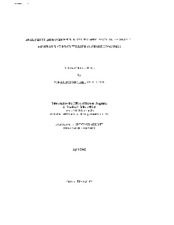| dc.creator | Tydlacka, Jonathan Michael | |
| dc.date.accessioned | 2013-02-22T20:40:53Z | |
| dc.date.available | 2013-02-22T20:40:53Z | |
| dc.date.created | 2002 | |
| dc.date.issued | 2013-02-22 | |
| dc.identifier.uri | https://hdl.handle.net/1969.1/ETD-TAMU-2002-Fellows-Thesis-T92 | |
| dc.description | Due to the character of the original source materials and the nature of batch digitization, quality control issues may be present in this document. Please report any quality issues you encounter to digital@library.tamu.edu, referencing the URI of the item. | en |
| dc.description | Includes bibliographical references (leaf 16). | en |
| dc.description.abstract | The purpose of this project was to perform micro-simulation analyses on intersections near Highway-Railroad Grade Crossings to determine if controlling mean train speed and train speed variability would improve safety and reduce delays. The first of two objectives for this project required the completion of a micro-simulation model and the subsequent checking of the model for errors and accuracy. The second part consisted of train speed sensitivity analyses on mean train speed and train speed variability. A micro-simulation model of the Wellborn Corridor in College Station, Texas was created using VISSIM. The model was run ten times in each of the nine train speed distributions. Average delay was collected for each of the four intersections in the model. Additionally, the model was run with alternate train detection distances and select train speed distributions, and average delay was again collected. For each train speed distribution and intersection, delays were compared using the t-test with a 95% confidence interval. Comparisons were made against train speed distributions with either the same mean speeds, the same standard deviations, the base train speed, or the same distribution with a different train detection distance. Furthermore, these comparisons were made for each of the four lo-minute intervals of the simulation. Significant differences were found only in the second time interval, when the trains were present. Some significant differences were found when the mean train speeds were altered, and these were more prevalent at the high volume intersection, George Bush Dr. However, the number of statistically different comparisons was still not considered substantial. Ultimately, it was found that manipulating the train detection distance, the mean train speed, or the train speed standard deviation did not have a significant effect on the average delay for the traffic layout that was modeled for this particular corridor. | en |
| dc.format.medium | electronic | en |
| dc.format.mimetype | application/pdf | |
| dc.language.iso | en_US | |
| dc.publisher | Texas A&M University | |
| dc.rights | This thesis was part of a retrospective digitization project authorized by the Texas A&M University Libraries in 2008. Copyright remains vested with the author(s). It is the user's responsibility to secure permission from the copyright holder(s) for re-use of the work beyond the provision of Fair Use. | en |
| dc.subject | engineering. | en |
| dc.subject | Major engineering. | en |
| dc.title | Analysis of improvements in system efficiency and safety at highway-railroad-pedestrian grade crossings | en |
| thesis.degree.department | engineering | en |
| thesis.degree.discipline | engineering | en |
| thesis.degree.name | Fellows Thesis | en |
| thesis.degree.level | Undergraduate | en |
| dc.type.genre | thesis | en |
| dc.type.material | text | en |
| dc.format.digitalOrigin | reformatted digital | en |


